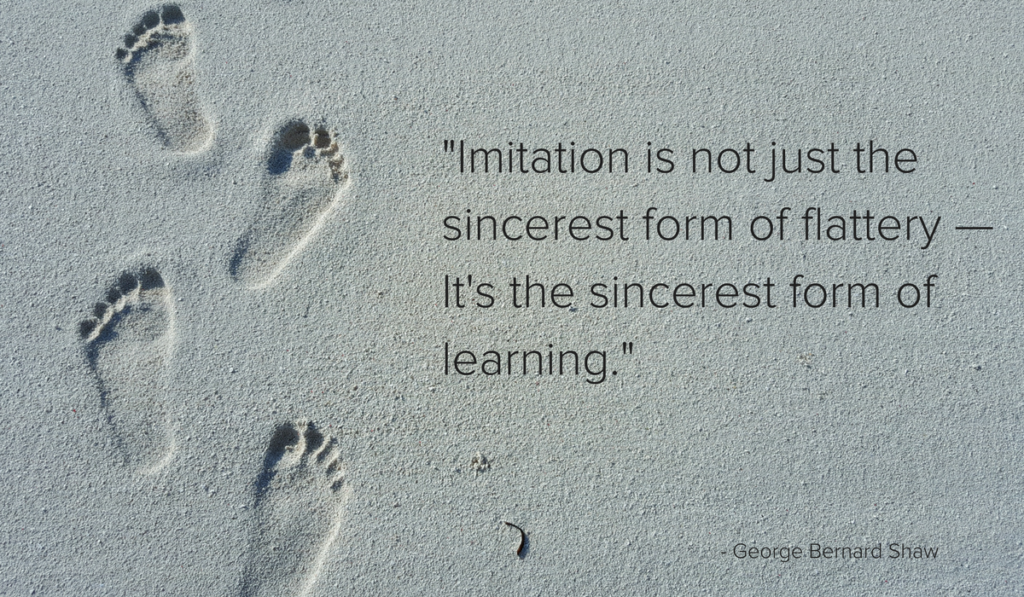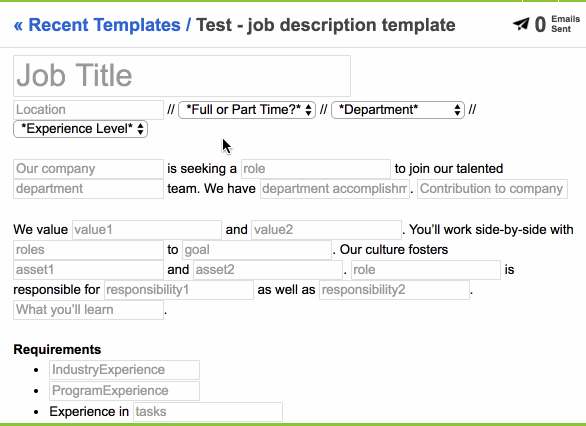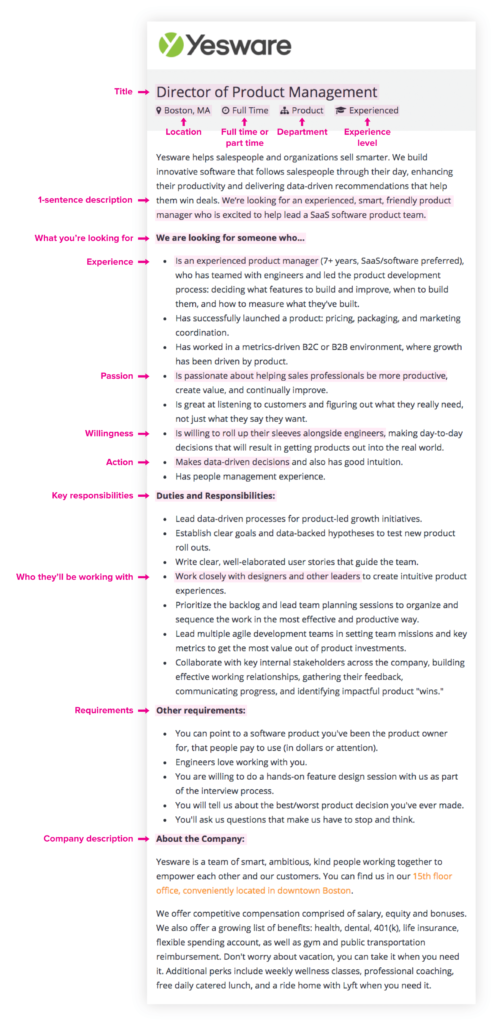Job Description Template: How to Attract More (Qualified) Candidates
Melissa Williams
A job description template is like a magnet.
It can either attract candidates or end up pushing them away.
Achieving that perfect pull can be tough — but you can get there by the end of this post. You’ll get a free template to work from, plus an easy tool to save you time typing.
Pro Tip: Find out when candidates (& colleagues) open your emails with Email Tracking.
3 Secrets To Standing Out From The Recruiting Competition
People leave their job for a reason.
When they’re out in the hiring pool wilderness, pull them in by showing that your role has what they’re looking for.

Secret 1: Talk about the future
According to the Bureau of Labor Statistics, three million Americans voluntarily have left their jobs in each month of 2017.
And three out of every four employees do so because of a lack of advancement opportunities.
What to do: Draw job applicants in by mentioning this magic phrase in your job description: career growth.
“When we include this phrase in our job descriptions, over half of candidates ask about it in the first call,” says Zoe Silverman, Yesware’s Director of Talent.
“Make sure you tailor your conversation to what you know a specific role typically looks for. Especially for roles with a clear, common path in the industry. Look at inside sales as an example: an SDR wants to become a senior SDR, then an AE, then a Sales Manager. “
Secret 2: Show your personality
Listing the right qualifications is only half of the battle; the other is standing out from the crowd.
What to do: Give your job description template some personality by bringing in a sense of humor. This can be as small as two words breaking through a list of dry qualifications:
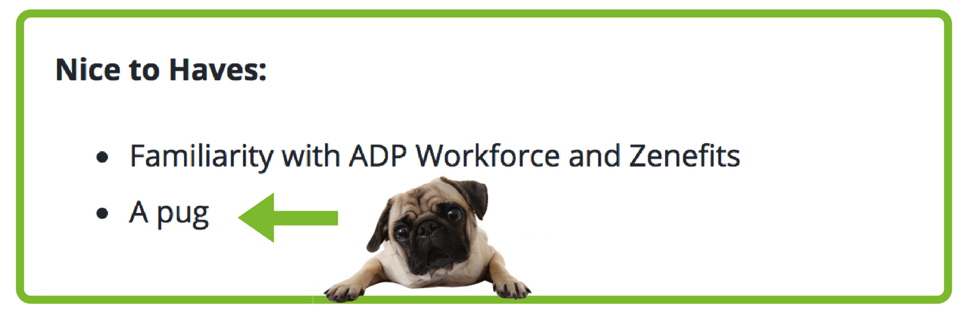
Secret 3: List out your values
Attracting and hiring one wrong person can cost your company more than $50,000.
Someone could have every skill you need, but if their values don’t align, they could walk out the door in months.
A “culture add” means someone who has the same values as your company just as much (if not more so) than conversational chemistry with your team.
What to do: Explicitly list your core values in your job description template. The more you include, the better you set expectations for candidates who apply.
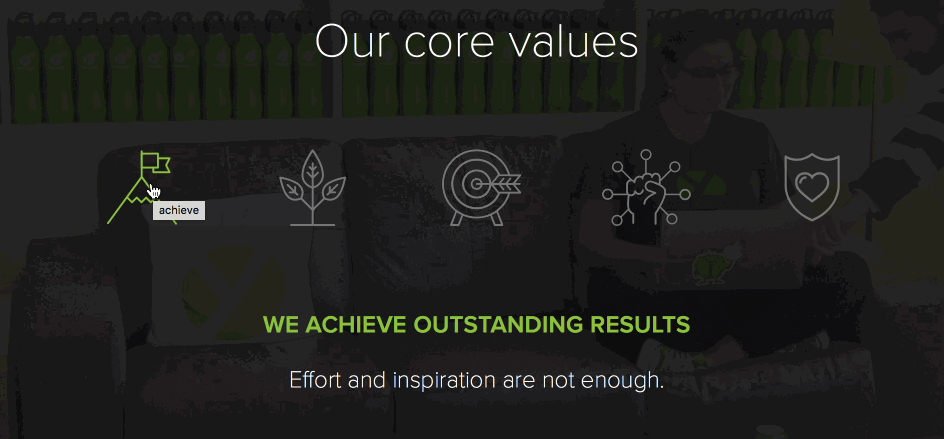
Download a job description template that incorporates the 3 secrets above for you.
7 Job Description Mistakes That Turn Qualified Candidates Away
Posting a job means becoming an expert balancer.
You’re weighing the demands of your hiring team with consistency in a job description template.

When you’re out there holding it all together, avoid falling into these easy mistakes:
1. Breaking consistency with the formatting of your bullets.
You might think getting the right content into your post is the most important thing. It’s not.
Candidates are judging your company on the way you format your content.
It’s exactly what you do with resumes, but in reverse.
The fix: Check before you publish: Is the first word of every bullet a consistent part of speech (i.e. noun or verb)?
2. Skipping one minute to simplify your language.
Remember the word “supercalifragilisticexpialidocious”?
Imagine how hard that word would be to read if you didn’t know it already.
Lengthy job descriptions are as much a mouthful for your mind.
Today’s average attention span is eight-seconds, so you need to keep your language simple and scannable.
The fix: Don’t overuse buzzwords in your job description. They weaken your content and people see right through them. Instead, plug your listing into a tool like Hemingwayapp for short, bold sentences.
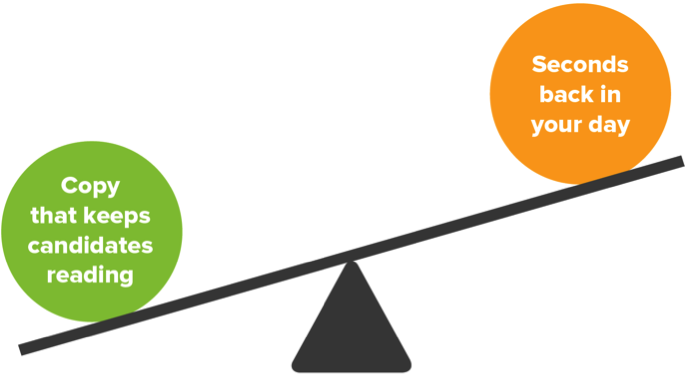
Pro Tip: Use this tool to save your recruiting emails as templates in your inbox
3. Having typos and/or grammar mess-ups.
Would you put a welcome mat in front of your home with a typo in it?
Probably not.
Well, publishing a job with mistakes gives candidates a similar bad impression. Like so:
@AP_Jobs Do we get the job automatically if we point out a typo in the job description? 🙂 pic.twitter.com/taed8F3NCG
— Justin Fleenor (@JustinFleenor) July 30, 2017
The fix: Use this tool to save job descriptions in your inbox — so you stop re-typing and start inserting typo-free templates.
4. Being too shy to list out must-haves.
If you bring in job candidates who you later turn away because they all lack the same thing, you have a problem. Whether it’s a degree or type of experience, you didn’t set it as a must-have in your description.
Which welcomed those candidates to apply.
Think about the time each interviewer spends on candidates you turn away. (Then times that by their hourly wage, and add it all).
That’s a costly oversight.
The fix: Pull must-haves up front into the job description. Suck it up and ask your hiring managers, “What will you not hire without?”
If they can’t think of something, ask, “what are some qualities that lead to success in this role? How important is it to you that candidate has this?” Have them qualify the requirement by ranking it from 1 to 5. Add anything with a 4 or 5 as a must-have in your job description.
5. Forgetting to list details to help candidates turn you down sooner.
If your office is in a suburb, and you’re listing “Greater [insert city name] Area” as your location, that can be deceiving. Especially if candidates are picky about the distance they’re willing to commute.
And it could end up wasting your team’s time.
The fix: Make sure you list the exact location, whether the role is full-time or part-time, and who the role reports to.
You’ll find that the way-off-the-grid submission pool gets much smaller after this change.
Pro Tip: Make interview scheduling easier with this meeting booker. [free trial]
6. Leaving the listing up to the hiring manager.
Motive is behind everything we do throughout every single day.
We get up in the morning because we want to get things done during the day.
We work because we want to make money to support ourselves.
And hiring managers gather qualifications because they want to find the right candidate.
But what if you’re forgetting the things that candidates want and won’t say “yes” without?
The fix: Put yourself in a candidate’s shoes and think: what makes a person in this role tick? (Keep reading for help)
7. Assuming you’re being inclusive. (You’re not)
“Ambiguity leads to non-inclusive hiring processes,” says Zoe, Yesware’s Director of Talent.
“Some people qualify themselves out, others qualify themselves in.”
Companies want to increase diversity, but many of them write listings from a majority standpoint. And this pushes away minority candidates.
In a 2017 study of 347 recruiters, 77% of companies rated diversity a 6 to 10 out of 10 as a priority. Yet 56% of them struggled to find relevant candidates.
The fix: If you have a diversity statement, list it at the end of your job description template.
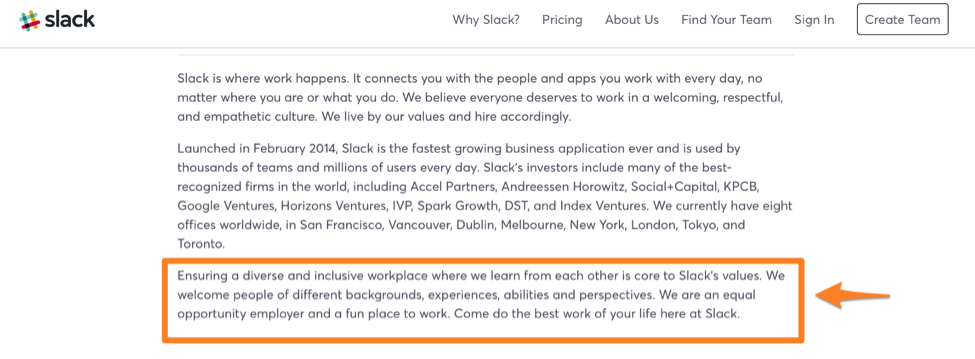
“There are little, hidden things like this that you don’t notice if you’re not a minority,” says Zoe Silverman. “But when they do apply to you, and they’re listed, these things say “Hey, we support you and we want you to work here.””
Make Sure You’re Absolutely Positively Doing These 4 Things
Fast Hack:
What’s the most powerful way to put a candidate in the shoes of the role you’re hiring?
Include these four words to help candidates visualize the team they’d work with:
“We are looking for…”
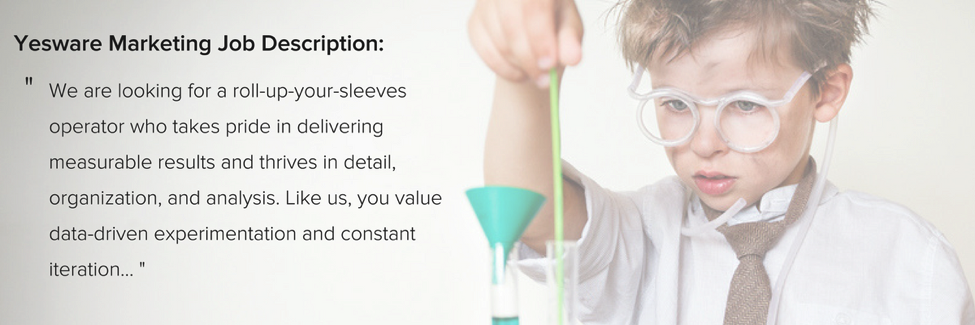
This breaks them away from the words and helps them picture how they’d fit into the puzzle.
Visualization is powerful. Studies have proven that thinking about something as small as flexing your wrists can actually make them 2x stronger.
Template to copy: “We are looking for a {!adjective} {!noun} who takes pride in {!action} and thrives in {!thing 1}, {!thing 2}, and {!thing 3}. Like us, you value {!company value 1} and {!company value 2}.”
Fast Hack:
Here’s how to give yourself a leg-up against your competitors in 60 seconds…
Go check out their Careers page.
It’s not just what you sell that’s competitive, it’s the talent that you’re attracting and retaining.
How do they write about the company, the team, and the roles that they’re hiring for?
What to do: If you see a line that you like, tweak it to make it your own.
Not seeing anything steal-worthy on your competitor pages? Feel free to check out ours:
Fast Hack:
Save a job description template that works for any department and role.
Fast Hack:
Get a process in place for roles where you need to meet with someone to get the details.
What to do: Have a list of questions to run through with hiring managers. Like this:
- What’s the official title? Location? Full-time or part-time?
- Describe your ideal candidate.
- What’s the salary range here?
- What does your team value?
- Who will this person work side by side with?
- What will their responsibilities be?
- What would you absolutely not hire for this role without? What are the deal breakers?
Save it to a Google doc, a Note, or wherever you like to work. That way, you can quickly plug the information into your job description template when you’re ready.
11 Things Every Successful Job Description Template Includes
Free Download: Here’s your template (as a Google Doc) to get started right now.
Before you press “publish” on any job listing, double-check for the following:
- Title
- Location
- Full-time vs. Part-time
- Department
- General experience level
- A one-sentence description
- “Looking for someone who…” (Covers experience, passion, willingness, actions)
- Who you’ll be working with
- Key responsibilities (all action-oriented duties)
- Requirements
- About the company (values, benefits, awards)
Here’s how that plays out in a real job description example:
Get sales tips and strategies delivered straight to your inbox.
Yesware will help you generate more sales right from your inbox. Try our Outlook add-on or Gmail Chrome extension for free, forever!
Related Articles
Anya Vitko
Casey O'Connor
Jenny Keohane
Sales, deal management, and communication tips for your inbox

